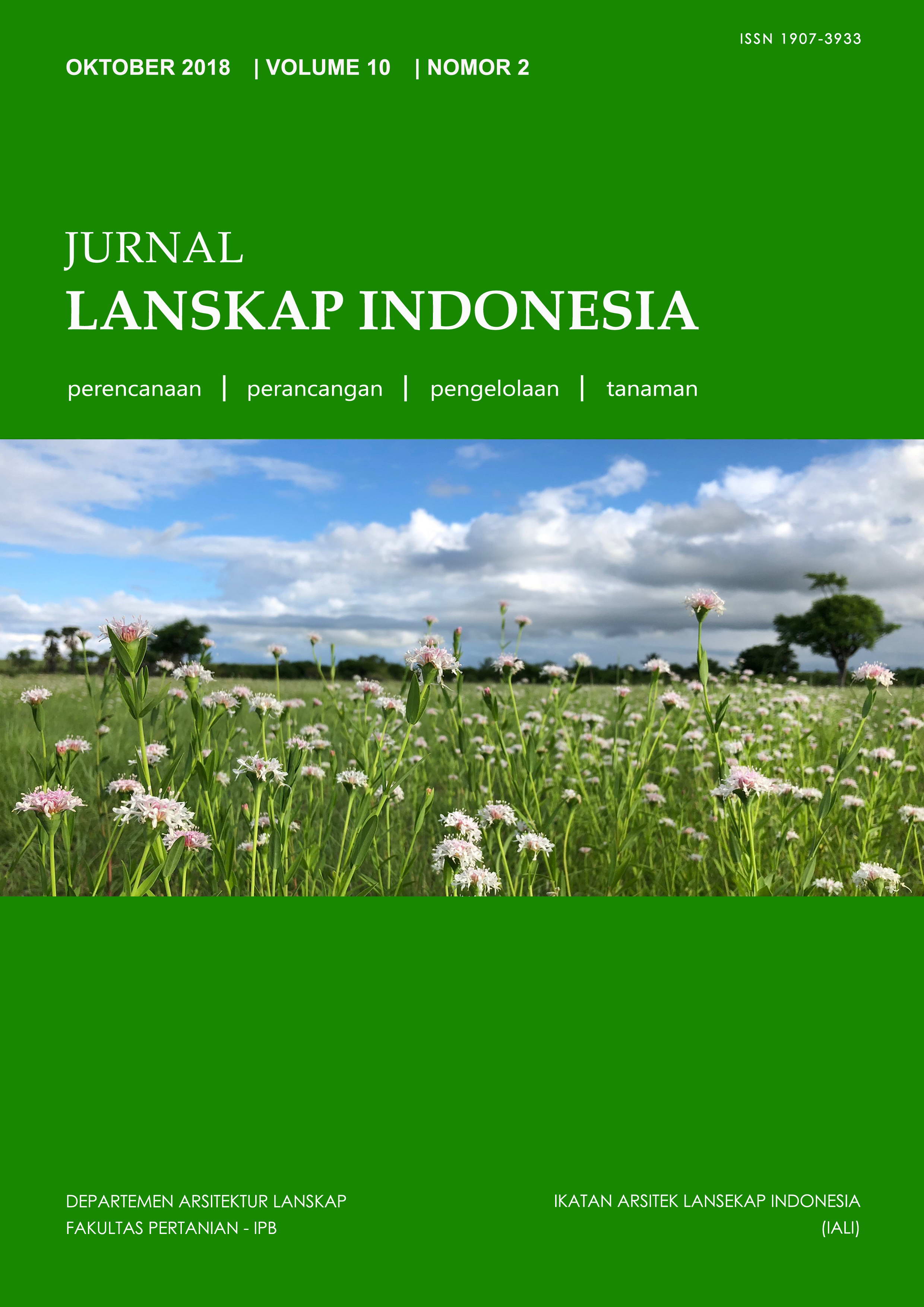PEMETAAN ZONA EKOLOGIS DAN IDENTIFIKASI GEOMORFOLOGI LANSKAP GEO-AREA CILETUH DI KABUPATEN SUKABUMI
Abstract
Geopark Nasional Ciletuh terletak di Geo-area Ciletuh, saat ini sangat dipromosikan dan sedang diupayakan untuk mendapatkan pengakuan dari UNESCO sebagai Global Geopark Network (GGN) pada tahun 2016, tetapi sampai sekarang belum menerima keputusan. Geo-area Ciletuh memiliki batuan khas yang terbentuk dari dua fragmen kerak bumi, lempeng samudera dan lempeng benua. Di sisi lain, keunikan dan keindahan sumber daya alam yang dimiliki oleh Geo-area Ciletuh dapat berdampak negatif pada dirinya sendiri. Penelitian ini bertujuan untuk mengidentifikasi zona ekologi lanskap dan pendekatan geomorfologi sebagai cara untuk mengatasi masalah dan mengantisipasi dampak negatif di masa depan. Zona ekologis kawasan Geo-area Ciletuh tergolong sedang, yaitu 72,03% dari total luas dengan penggunaan lahan seperti pertanian, perkebunan, dan sawah. Hasil analisis morfometrik didominasi oleh relief bergelombang lemah 35,36% atau cukup curam sebesar 37,08%. Jenis utama batuan yang terkandung (diurutkan berdasarkan kekuatan struktur) adalah Batu Breksi Tufa (37,09%), Batupasir Kwarsa (13,80%), Batupasir Gamping (6,89%), Batupasir Tufa (15,53%), Tanah Liat (22,62%, dan Pantai). Aluvial Sludge (4,07%).
Downloads
References
Adriani, Hanni. 2016. Perencanaan Lanskap Kawasan Wisata Berkelanjutan di Kecamatan Cisarua Kabupaten Bogor. [Tesis]. Arsitektur Lanskap. Institut Pertanian Bogor
Alamsyah S, Gandapurnama B. 2017. Pesona Batu Jutaan Tahun di Ciletuh Geopark yang Dilindas Crosser. https://news.detik.com/berita-jawa-barat/d-3580295/pesona-batu-jutaan-tahun-di-geopark-ciletuh-yang-dilindas-crosser. (diakses 14 September 2017).
Aukerman, Hass, Associates,LLC. 2011. Water and Land Recreation Opportunity Spectrum (WALROS). Colorado: U.S. Department of the Interior Bureau of Reclamation.
Azman N, Sharina Ah, Ong PL, Salsela S, Ibrahim K. 2010. Public education in heritage conservation for geopark community. Procedia social and behavioral sciences. 7(c): 504-511.
Dasiharjo, Supriatna U, Saputra IM. 2016. Pengembangan Geopark Ciletuh Berbasis Partisipasi Masyarakat Sebagai Kawasan Geowisata di Kabupaten Sukabumi. Jurnal Manajemen Resort dan Leisure, Vol. 13 No.1, 55-60.
Lavinda. 2017. Menhub sebut tiga opsi lokasi bandara baru di Sukabumi.. https://www.cnnindonesia.com/ekonomi/20171107204012-92-254192/menhub-sebut-tiga-opsi-lokasi-bandara-baru-di-sukabumi. (Diakses 19 Desember 2017).
Mangunsukardjo, Karmono. 2002. Kajian Geomorfologi Untuk Perencanaan Penggunaan Lahan di Daerah Aliran Sungai Oyo, Gunungkidul, Daerah Istimewa Yogyakarta. Majalah Geografi Indonesia. Fakultas Geografi Universittas Gadjah Mada.
Sukamto, Rab. 1975. Geologi Lembar Jampang dan Balekambang Jawa. Pusat Penelitian dan Pengembangan Geologi Direktorat Pertambangan Umum Departemen Pertambangan dan Energi, Bandung, Indonesia.
Surat Keputusan Menteri Pertanian Nomor 837/Kpts/Um/11/1980 Tanggal 24 Nopember 1980 tentang Kriteria dan Tata Cara Penetapan Hutan Lindung.
Peraturan Direktur Jenderal Konservasi Sumber Daya Alam dan Ekosistem Nomor P.11/KSDAE/SET/KSA.0/9/2016 tentang Petunjuk Teknis Rancangan Zona Pengelolaan atau Blok Pengelolaan Kawasan Suaka Alam dan Kawasan Pelestarian Alam.
Peraturan Pemerintah Republik Indonesia Nomor 26 Tahun 2008 tentang Rencana Tata Ruang Wilayah Nasional.
Zuidam, R.A Van. 1979. Guide to Morphology Areal Topographic Interpretation and Mapping.
ITC Textbook of photo interpretation vol VII, International Institute for Aerial Survey and Earth Science, Netherlands, 230.
Zuidam, R.A Van. 1985. Aerial Photo-Interpretation Terrain Analysis and Geomorphology Mapping. Smith Publisher The Hague, ITC
This journal permits and encourages authors to post items submitted to the journal on personal websites or institutional repositories both prior to and after publication, while providing bibliographic details that credit, if applicable, its publication in this journal. However, after the article is submitted and published in this journal, it is fully copyrighted by the Jurnal Lanskap Indonesia or JLI. If excerpts from other copyrighted works are included, the author must obtain written permission from the copyright owner and give credit to the source in the article. Then, the writer or reader is allowed to copy, share, and redistribute articles/material in any form. But it must still include the appropriate source and credit because the article in this journal is licensed by Creative Commons Attribution 4.0 International License (CC BY 4.0).
I. Proposed Policy for Journals That Offer Open Access
Authors who publish with this journal agree to the following terms:
- Authors retain copyright and grant the journal right of first publication with the work simultaneously licensed under a Creative Commons Attribution License that allows others to share the work with an acknowledgement of the work's authorship and initial publication in this journal.
- Authors are able to enter into separate, additional contractual arrangements for the non-exclusive distribution of the journal's published version of the work (e.g., post it to an institutional repository or publish it in a book), with an acknowledgement of its initial publication in this journal.
- Authors are permitted and encouraged to post their work online (e.g., in institutional repositories or on their website) prior to and during the submission process, as it can lead to productive exchanges, as well as earlier and greater citation of published work (See The Effect of Open Access).
II. Proposed Policy for Journals That Offer Delayed Open Access
Authors who publish with this journal agree to the following terms:
- Authors retain copyright and grant the journal right of first publication, with the work after publication simultaneously licensed under a Creative Commons Attribution License that allows others to share the work with an acknowledgement of the work's authorship and initial publication in this journal.
- Authors are able to enter into separate, additional contractual arrangements for the non-exclusive distribution of the journal's published version of the work (e.g., post it to an institutional repository or publish it in a book), with an acknowledgement of its initial publication in this journal.
- Authors are permitted and encouraged to post their work online (e.g., in institutional repositories or on their website) prior to and during the submission process, as it can lead to productive exchanges, as well as earlier and greater citation of published work (See The Effect of Open Access).



























